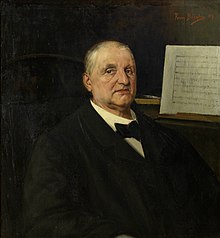布鲁克纳节奏

布鲁克纳节奏是安东·布鲁克纳的交响乐中的2+3(二连音+三连音)或 3+2节奏,它频繁[1][2]且以许多不同形式出现。[3]

布鲁克纳还在他的第二交响曲中使用了重复单个音高的节奏(例如,第20和122小节)。[5]在他的第六交响曲中,布鲁克纳节奏出现的程度比以前的作品要多得多,在几个部分出现的时间略有不同。一开始,它作为小提琴音域中高音弦以固定音出现,与大提琴中不同节奏的旋律(第3小节)[6]相对应,而在第 195-209小节,它用于表达六声音阶循环和弦。 [7]这种节奏在第八交响曲的次要主题组中以更“易于处理”的形式出现,通常在所有部分中以相同的方式出现。

布鲁克纳节奏也出现在其他作曲家的作品中,例如在霍华德汉森的浪漫主义交响曲中,它主要出现在圆号和小号部分。
参考资料[编辑]
- ^ Milton John Cross & David Ewen, Encyclopedia of the Great Composers and Their Music. New York: Doubleday (1962): 158. "The second element is a rhythmic pattern so often employed by the composer that it is known as the "Bruckner rhythm."
- ^ Hans-Hubert Schönzeler. Bruckner. London: Marion Boyars Publishers. 1978: 59.
- ^ John Williamson, "The Brucknerian symphony: an overview", The Cambridge Companion to Bruckner, ed. John Williamson. Cambridge, Cambridge University Press (2004): 79. "Yet even so instantly recognizable a rhythmic tic can be used with great variety."
- ^ Benjamin Korstvedt, "Aspects of Bruckner's approach to symphonic form" The Cambridge Companion to Bruckner, ed. John Williamson. Cambridge, Cambridge University Press (2004): 186.
- ^ Derek Watson, Bruckner. New York: Schuster & Macmillan (1997): 81
- ^ (Williamson, 2004): 79
- ^ Kevin Swinden, "Bruckner and harmony" The Cambridge Companion to Bruckner, ed. John Williamson. Cambridge, Cambridge University Press (2004): 222. "The orchestral texture through this passage is thick, articulating block chords in the 'Bruckner-rhythm' that characterizes the movement, supporting a reprise of the first theme of the symphony."
外部链接[编辑]
- Symphonie no 2 de Bruckner: 国际乐谱典藏计划上的乐谱
- Time analysis Symphony No. 2 (页面存档备份,存于互联网档案馆), William Carragan
- Symphonie no 4 de Bruckner: 国际乐谱典藏计划上的乐谱
- Time analysis Symphony No. 4 (页面存档备份,存于互联网档案馆), William Carragan
- Symphonie no 6 de Bruckner: 国际乐谱典藏计划上的乐谱
- Time analysis Symphony No. 6 (页面存档备份,存于互联网档案馆), William Carragan
- Time analysis Symphony No. 8 (页面存档备份,存于互联网档案馆), William Carragan
